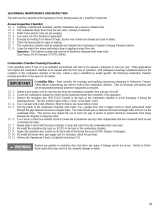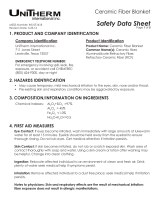Page is loading ...

Safety Data Sheet
Ceramic Fiber Blanket
MSDS Number: CF Revision Date: 6-1-16
Page 1 of 6
1. PRODUCT AND COMPANY IDENTIFICATION
2. HAZARDS IDENTIFICATION
• May cause temporary, mild mechanical irritation to the eyes, skin, nose and/or throat.
• Pre-existing skin and respiratory conditions may be aggravated by exposure.
3. COMPOSITION/INFORMATION ON INGREDIENTS
Chemical Indexes: Al
2
O
3
+SiO
2
>97%
Al
2
O
3
> 45%
Fe
2
O
3
<1.0%
Na
2
O+K
2
O<=0.5
4. FIRST AID MEASURES
EYE CONTACT:
If eyes become irritated, wash immediately with large amounts of lukewarm water for at
least 15 minutes. Eyelids should be held away from the eyeball to ensure thorough rinsing.
Do not rub eyes. Get medical attention if irritation persists.
SKIN CONTACT:
If skin becomes irritated, do not rub or scratch exposed skin. Wash area of contact
thoroughly with soap and water. Using a skin cream or lotion after washing may be
helpful. Change into clean clothing.
INGESTION:
Relocate affected individual to an environment of clean and fresh air. Drink plenty of
water seek medical help if symptoms persist.
INHALATION:
Remove affected individual to a dust free place; seek medical help if irritation persists.
Company Identication
DS Industries
711 Jones Street
Lewisville, Texas 75057
EMERGENCY TELEPHONE NUMBER:
For emergency involving spill, leak, re,
exposure, or accident call CHEMTREC
(800) 424-9300, day or night
Product Identication
Product Name: Ceramic Fiber Blanket
Common Name(s): Ceramic ber,
Aluminosilicate Refractory Fiber,
Refractory Ceramic Fiber (RCF)

Safety Data Sheet
Ceramic Fiber Blanket
MSDS Number: CF Revision Date: 6-1-16
Page 2 of 6
Notes to physicians: Skin and respiratory effects are the result of mechanical irritation:
ber exposure does not result in allergic manifestations.
5. FIRE FIGHTING MEASURES
Non-combustible (does not burn) product.
Auto-ignition temperature: none
NFPA Unusual Hazards: none
Unusual re and explosion hazards: none
Extinguishing Media: use proper extinguishing media for the surrounding re.
Fire ghting protective equipment: wear full bunker gear including positive pressure self-
contained breathing apparatus.
6. ACCIDENTAL RELEASE MEASURES
Avoid creating airborne dust. Maintain routine housecleaning procedures. Vacuum only
with HEPA ltered equipment, if sweeping is necessary, use a dust suppressant and keep
material in closed containers. Do not use compressed air for cleanup. Workers should
wear gloves, goggles and approved respirator. Avoid cleanup procedures that could
cause water pollution.
7. HANDLING AND STORAGE
CLEAN-UP:
Clean up dust carefully. Use wet sweeping or high efciency vacuum to remove dust.
Do not use compressed air.During after-service removal activities, wet exposed material
frequently to minimize airborne dust. A surfactant may be added to the water to improve
the wetting process. Use only enough water to wet the insulation. Do not allow water to
accumulate on oors.
EMPTY CONTAINERS:
Product packaging may contain residue. Do not reuse.
8. EXPOSURE CONTROLS/PERSONAL PROTECTION
Components OSHA Supplier:
Alumino--silicate ber None established
ACGIH TLV:
Aluminosilicate ber—none established

Safety Data Sheet
Ceramic Fiber Blanket
MSDS Number: CF Revision Date: 6-1-16
Page 3 of 6
For Alumino--silicate ber, refer to OSHA guidance regarding”Particulates not otherwise
Regulated”(PNOR). Control airborne dust levels as follows:
Components Particle size OSHA:
PNOR total dust 15mg/m3
Respirable dust 5mg/m3
ACGIH particulates not otherwise classied (PNOC)—INHALABLE
PARTICULATE: 10mg/m3. RESPIRABLE PARTICULATE: 3mg/m3
Other Occupational Exposure Levels (OEL)
RCF-related occupational exposure limits vary from country to country. Listed here are a
few regulatory OEL examples: Australia--0.5f/cc; Austria—0.5f/cc;
Canada—0.5 to 1 f/cc; Denmark—1 f/cc
France—0.6 f/cc; Germany—0.5 f/cc; Netherlands—1 f/cc; United Kingdom—2 f/cc
Example is: RCFC REG 0.5 f/cc. The objectives and criteria underlying each of these OEL
decisions also vary. The evaluation of occupational exposure limits and determining their
relative applicability to the workplace is performed on a case-by-case, by a qualied
industrial hygienist.
Eye Protection:
In case of overhead work, wear goggles or safety glasses with side shields to prevent eye
contact.
Skin Protection:
Wear gloves, head covering and full body clothing as necessary to prevent skin irritation.
Respiratory Protection:
When effective engineering and administrative controls are insufcient, the use of
appropriate respiratory protection, pursuant to the requirements of OSHA 1910.134 and 29
DFR 1926.103 for the particular hazard or airborne concentrations in the work place, it is
recommended. For dust concentrations below applicable exposure limit value.
9. PHYSICAL AND CHEMICAL PROPERTIES
Oxidizing properties: None

Safety Data Sheet
Ceramic Fiber Blanket
MSDS Number: CF Revision Date: 6-1-16
Page 4 of 6
Chemical family: Aluminosilicate bers
Chemical Indexes: Al
2
O
3
+SiO
2
>97%
Al
2
O
3
>45%
Fe
2
O
3
<1.0%
Na
2
O+K
2
O<=0.5
Boiling Point: N/A
Odor: No Odor
Solubility: N/A
Melting Pt.: 3200°F
Vapor Density: N/A
10. STABILITY AND REACTIVITY
Chemical stability: stable under conditions of normal use.
Incompatibility: hydrouoric acid, and concentrated alkali.
11. TOXICOLOGICAL INFORMATION
Epidemiological studies conducted by institution of human environment protection in
China has provided no evidence that there is a direct cause-and effect relationship
between cumulative exposure to aluminosilicate bers and lung cancers or particular
pulmonary diseases.
However recent toxicological experiments using physiological exposure method
(inhalation) have produced ndings of respiratory disease in rodents, Aluminosilicate
refractory ber has found to be a rodent carcinogen under the conditions that the
rodents are exposed to high levels of the material (75—115bers/cc) on a basis of lifetime
duration.
12. ECOLOGICAL INFORMATION
No data is available on adverse effects of the material on the environment.
13. DISPOSAL CONSIDERATIONS
As produced, this material is usually accepted for disposal at most sites licensed for the
disposal of industrial waste. Check applicable regulations and waste site policies prior to
disposal. Waste should be paced containers for disposal.
In case of contamination, by other materials classied as hazardous waste, expert
guidance should be sought.

Safety Data Sheet
Ceramic Fiber Blanket
MSDS Number: CF Revision Date: 6-1-16
Page 5 of 6
14. TRANSPORT INFORMATION
Product should remain in sealed containers during transportation.
15. REGULATORY INFORMATION
CERCLA: the aluminosilicate bers of this product have an average diameter of 2-4 um
and are not considered CERCLA hazardous substances (CERCLA 40 CFR302)
Clean Air Act (CAA): thermal insulation bers are composed of (RCF) with an average
diameter greater than 1 micron, and therefore are not considered hazardous air
pollutants.
Toxic Substances Control Act (TSCA): all substances in this product are listed, as required,
on the TSCA chemical inventory.
International Regulations:
Canadian Workplace Hazardous Materials Information System (WHMIS):
No Canadian Workplace Hazardous Materials Information System categories apply to this
product.
Canadian Environmental Protection Act (CEPA):
All substances in this product are listed, as required, on the Domestic Substances List
(DSL). Chemicals, which are listed on the Non—Domestic Substances list:
16. OTHER INFORMATION
Removal after service: Under sustained and steady high temperature over 1800°F, this
material will possibly transform to crystalline silica (ciystobalite) in exposed portions.
Prolonged or repeated exposure to respirable crystalline silica dust may lead to lung
diseases. IARC has listed crystalline silica in Category 2A a probable carcinogen (“
crystalline silica inhaled in the form of quartz or cristobalite from occupational source is
carcinogenic to humans” IARC monograph 68, June 1997 p 210—211). The permissible
exposure limit(PEL) set by OSHA for respirable cristobalite is 0.05mg/m3. Whenever
possible follow section 8 procedures for exposure controls and personal protection.
Abbreviations:
CERCLA: comprehensive environmental response compensation and liability act of 1980
CAS: Chemical abstracts service
F/cc: bers per cubic centimeter
HMIS: Hazardous Material information system

Safety Data Sheet
Ceramic Fiber Blanket
MSDS Number: CF Revision Date: 6-1-16
Page 6 of 6
Mg/m3: Milligrams per cubic meter of air
NIOSH: National institute for Occupational Safety and Health
OSHA: Occupational Safety and Health Administration
PEL: permissible exposure limit
SARA: super amendments and reauthorization act
TSCA: toxic Substances Controls Act
/



